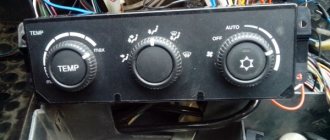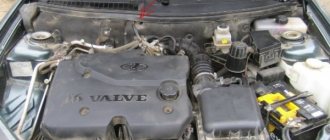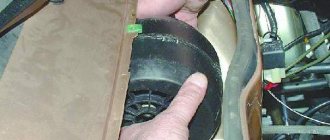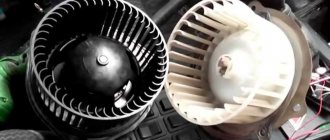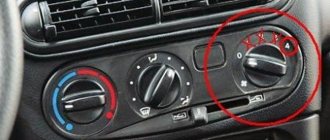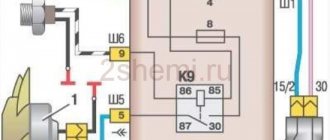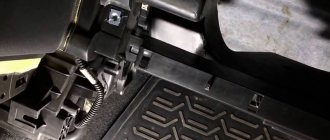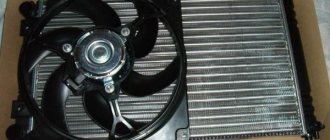Don’t panic. No need to think that the climate control unit has burned out (at a cost
6,000 rubles). In general, do not rush to spend money on expensive repairs. My Priora glass model 2009, luxury+ equipment, Halla Conder The heater did not turn on at any speed... Due to jamming of the electric heater fan due to icing or when some foreign particles got into the impeller, under the hood, approximately in the center frill, under the wiper (see photo) a cheap thermal fuse burns out: 250v, 10A, 142 °C, which is installed in a very expensive speed controller (if I’m not mistaken
The Lada Priora is in many ways similar to its progenitor, the VAZ of the tenth family, including the design of the heater. The manufacturer decided to leave the operating principle of the stove, replacing only some elements with new ones. At the same time, Lada Priora also inherited familiar problems, for example, when the stove does not heat and blows cold air.
Heating system elements (stoves)
The fact that the Priora stove is 95% similar to the “ten” can be seen by the catalog numbers:
- Heater assembly (2170-8101012 or 2111-8101012-10).
- Air flow distribution gearmotor (2170-8127100). Distributes air flow to the feet/face/windshield. Located inside the dashboard.
- Interior air temperature sensor (11186-8128050). Located on the ceiling.
- Heater control controller (HCU) or stove control unit (21703-8128020). The block on which the driver sets the operating parameters of the stove. Located on the panel.
- Additional resistor or additional resistor (2123-8118022). Determines the rotation speed of the stove fan. Secured in the engine compartment.
- Electric heater fan (2111-8118020). Located under the hood.
- Heater damper motor reducer (2110-8127200). Distributes air flows into the cabin (outside/heater radiator). Inside the heater assembly.
- Air filter (2110-8122020).
- Heater radiator (2110-8101060). Located inside the heater.
A malfunction of one of these elements causes problems in the operation of the stove.
Temperature sensor and control unit
Switching may be difficult due to malfunctions in the temperature sensor located inside the car. You can find it in the lampshade on the ceiling of the cabin. The regulator changes the mode, transmitting data on the air temperature in the cabin to the gearbox. Depending on the temperature, the damper closes or opens. The serviceability of this element of the heating system affects the correct operation of the stove.
Heating a car depends on the operation of the entire heating control unit. It is in it that the distribution of air jets occurs, the strength of the direction of air flows to one or another part of the cabin is determined, and the temperature value is determined. It is better if the reason for the failure is the resistance of the Priora stove, since it is difficult to repair the unit. To make sure that the reason for the incorrect heating operation is in the unit, you need to remove your unit and replace it with one that is in working condition.
In cars with air conditioning, the speed controller often fails. In the event of a breakdown, the heating system does not work or turns on only in the maximum position. Such a breakdown occurs when the oven operates for a long time with the damper in the closed position. This is where overheating occurs.
Finding the cause of a malfunction is not difficult if you understand the principles of operation of parts and assemblies. The correct sequence of work will allow you to eliminate the breakdown in a short time.
In the winter months, you need to find out why the stove is not working and cold air is blowing on a Priora (or other domestically produced car) as quickly as possible. Of course, you won’t turn into ice and don’t risk freezing anything. But driving with the heating not working is, at a minimum, unpleasant and fraught with all sorts of colds.
And driving out onto the highway is completely dangerous: God forbid, something breaks, you will really freeze until help arrives. Priora is the generally recognized descendant and successor of the Lada “ten”.
And the manufacturer did not make any fundamental design changes to the stove; only individual elements were changed. Accordingly, the diseases inherent in the ancestor were inherited by the descendant. All Priora owners unanimously assure that the heating system in it is very unreliable and can break down in several components. The worst thing is that in the summer few people remember about the stove and are puzzled by checking it. Therefore, discomfort is detected suddenly and requires lightning-fast action.
Why doesn't the heater work and blows cold air on the Priora?
There are many reasons for this. In descending order of frequency of cases, they can be arranged as follows:
- The stove damper is stuck. It does not open and does not allow warm air into the cabin. By the way, the opposite option is also possible: if it is closed in the open position, you begin to feel like you are in a sauna;
- The heating gear motor is broken;
- The stove control unit does not work;
- Problems in the engine cooling system;
- The temperature sensor in the cabin has broken down, and the heating system simply does not know that you are cold. Again, in a similar but opposite case, it may be hot.
Clogged filter
Experienced Prior owners have developed an algorithm of actions to find out where the heating system is leaking.
First approach
Before all checks, you need to make sure that the fan is working - it would be unreasonable to go deeper if the main element does not spin. The next steps are as follows.
- The engine heats up to the desired temperature;
- The pipes leading to the heater are probed. Both are hot - okay, one is at ambient temperature - which means there is no filler circulation;
- The hood opens, the tap is located and turns to another position. If it has become stuck, you will have to soak it immediately.
- The system is checked for leaks. The detected ones are eliminated: a constant lack of coolant is also the cause of cold airflow;
- The tap is working, there is no leak - the plug is removed from the tank and the liquid level is checked. Often an air lock forms in the tank; in this case, the coolant is topped up to normal, and the gas pedal is pressed sharply several times. The fluid circulation will resume and squeeze the plug out of the reservoir;
- To make the last step more effective, it is better to drive the front end onto the nearest hillock so that the car’s radiator is lower than the stove radiator.
Second approach
When (or if) both pipes are filled with hot liquid, we move on to the dampers.
- Again you will have to climb under the hood, this time to observe the operation of the damper;
- If it is warped or jammed, you can try to gently shake it with your hand from inside the cabin. To do this, remove the central deflector and unscrew the plastic guides to reach the stuck element. Access is only possible for a thin limb, so it is advisable to invite a female person to the procedure if she does not mind;
- If there are serious problems with the damper (the fastenings have rusted, the plastic has warped due to temperature or it has cracked), alas, you will be faced with difficult work: you will have to disassemble half of the heating system.
Third approach
The microreducer is a complete headache. First, its status is checked:
- The left handle is moved to the “min” position. After a 15-second wait, the engine starts;
- The controller that monitors the self-propelled guns is disconnected;
- The tester measures readings
on both contacts. The resistance should be 800-1200 Ohms for units 1303.3854; 1313.3854 and 1333.3854; for controller 1323.3854 the norm is 3600-5000; - The same operation is carried out in the “max” position. Now the data is in the range of 3200-3500 for the first group and 1200-1600 for 1323.3854;
- If there is no resistance or its unchangeability, the track on the sensor has been erased. It is not sold separately, so you will have to change the entire MMR. It is clear that not all the reasons why the stove does not work and cold air blows on a Priora can be eliminated on your own.
However, by following the above recommendations, you will at least understand what is preventing you from driving comfortably.
And also estimate upcoming expenses. For example, if you have to change the entire SAUO unit, you will have to pay about 1.5 thousand rubles for it. plus the work of an electrician. Winter for a motorist results in a lot of unpleasant problems. What can we say about the increased danger associated with icy road surfaces, frozen door handles or a power unit that does not want to start. But even if you managed to sort out all the problems mentioned above, you still can’t go far in a car when the temperature inside the cabin is only a couple of degrees higher than outside, and even then only due to the warm air we exhale. A nightmare for any Lada Priora owner. Stove repair is a surefire diagnosis of a sudden problem, and we know how to deal with it.
Operating principle of the stove
To independently determine a heater malfunction, you should understand the principle of its operation.
The heater control controller receives a signal from the temperature sensor in the cabin and compares it with the temperature set by the driver. If there is a difference, then the KUO sends a signal to the heater gear motor (located under the hood) so that it closes or opens the heater dampers by a certain amount for a greater supply of cold or hot air.
After setting the required heater fan speed, the heater control controller sends a signal to an additional resistor (in the engine compartment), which, due to the built-in resistance, sends an adjusted signal to the fan. At maximum speed, the resistor is not used and the electric fan rotates at maximum speed.
conclusions
At this point, we can consider the problems of the furnace device on your car to be fairly fully resolved. Almost any motorist who has studied the principle of its operation can repair the stove on a Lada Priora. In the future, the maintenance process consists of sequential diagnostics of its structural parts according to the above diagram. Most faults, such as cold air flows, insufficient heating and others, have a very clear diagnosis, which makes it quite easy to localize and fix the problem.
If the stove blows cold air (does not heat)
There may be several reasons why the Priora’s stove does not heat well (the percentage of breakdowns based on the results of a survey among owners of this car is indicated in parentheses):
- There is a malfunction in the engine cooling system (the heater radiator is cold and cannot give off heat). Touch both heater core hoses; they should both be hot. Sometimes the reason lies in the radiator itself (defect, insufficiently productive) (8%).
- Dirty cabin filter. Try removing the filter for a while and checking the operation of the stove (2%).
- The heater damper does not work, it is simply jammed (17%).
- The heater gear motor is faulty (16%).
- The heater control unit is faulty (13%).
- The interior air temperature sensor is faulty. Try turning it off for a while and check the operation of the heater (6%).
Points 3-6 may also be the reason when only hot air is constantly blowing from the stove.
Heater radiator malfunctions
Another reason that the heater in a Lada Priora car is not working (cool air is blowing from the deflectors) may be the accumulation of dirt in the heat exchanger. When the cooling system operates, deposits accumulate in the engine block itself over time, which are then spread throughout the entire system, including into the heater radiator. These deposits interfere with its effective operation. The system will heat the air worse. In this case, the stove radiator can be completely replaced. It is removed from the motor side. Before work, you must definitely drain the antifreeze from the cooling system. Then dismantle the windshield wiper arms, the frill trim and move aside part of the soundproofing shield. Then disassemble the stove body, disconnect the wires, remove the fan motor together with the impeller and pull out the heat exchanger, disconnecting the supply hoses from it.
Lada Priora with Panasonic air conditioning, the stove operates in maximum mode, change the rheostat resistor
Lada Priora
with
air conditioning
(Panasonic)
the stove operates
in the highest mode, change the rheostat (resistor...
Operating principle of the stove
The heater is controlled by a controller, from which a signal is received to turn on the stove. The driver sets the temperature in the cabin. If the temperature sensor detects that the temperature has dropped below the set level, the controller sends a signal to change the opening width of the stove damper. In some cases, an electronic failure occurs; instead of hot air, cold air is supplied.
The controller also regulates the number of fan revolutions. It sends a signal to an additional resistor, which, in turn, adjusts the operation of the fan using the built-in resistance. The resistor may not be used at all - then the fan runs at maximum speed. Thus, it acts as a “brake” for this node. If the resistor breaks, the fan may not start at all.
The driver can control which direction the air flow will be directed. To do this, he needs to set the value on the dashboard. The control regulators bark a command to move the dampers.
Heating device design, common breakdowns
If for some reason a motorist decides to change the heater tap on a Priora, he must first understand the air conditioning system of the domestic vehicle, which will allow him to find out the true reason why the unit does not function properly (stopped blowing). In a situation where the heater begins to supply extremely cold air into the cabin, and the car does not have air conditioning, the owner of the movable property must check several important design details. As a rule, first of all, you should pay attention to such elements as the control regulator, fan and stove faucet.
To exclude the possibility of breakage of other parts and to look for the place where the Priora stove faucet is located, you will have to inspect the fan. The functioning of which, in particular the number of revolutions, depends on the temperature inside the car. The difference between warm and cold flow depends on the operation of the valve. As for the air that is supplied directly to the vehicle itself, it necessarily passes through the filter element, thanks to which everything is cleaned. Only after this the driver of the car can choose the direction of the airflow by adjusting the position of the dampers, manipulating the installation using the central console.
Why can a fan fail?
There are several types of malfunctions of the Priora heater fan. The most common are:
- The heater stopped working completely. In most cases, this is caused by the failure of a 25 A or F 9 fuse. Power is not supplied and the unit does not operate. The second reason may be a malfunction of the heater control unit.
- Noise during fan operation is most often caused by a foreign object getting into it. Most often, dry leaves get stuck between the blades (especially in autumn), this leads to the appearance of extraneous sounds.
- Only mode 4 of the stove works; in all others it does not turn on. This failure can be caused by a faulty resistor or control unit.
Not every car enthusiast can check and repair a complex stove system. If you are not well versed in auto electrics, then you should turn to professionals. Otherwise, you can use the instructions below.
Introduction
One of the most important devices of any car can be called its heating unit; the lack of normal operation of the stove is especially clearly felt in the cold season, when driving in a frozen car becomes simply extremely uncomfortable. In most cases, many malfunctions of the Lada Priora heating device are associated with the cooling system of the power unit. In view of this circumstance, we should first consider the problems that this particular device causes. At the same time, we learn about the structure of the stove itself and its components, which also tend to periodically fail.
Carrying out diagnostics and repairs: where to start
Let's deal with the most difficult case when the stove does not start. First, you need to check the engine cooling system, because malfunctions may be associated with it. Check the amount of fluid in the expansion tank. Its level should be between the minimum and maximum marks. If you constantly add fluid to the reservoir, it is necessary to eliminate the leak in the cooling system. Check the pipes and tighten the clamps. In winter, you can only fill in a minimum amount of liquid, so it will heat up faster and warm air will flow into the cabin.
No heating at idle
It is not for nothing that this issue has been submitted for separate consideration, since it worries many motorists and solving the problem can be much more difficult than one might expect. So, you have a Priora, the heater does not heat up at idle, although when the car is moving, the interior is heated in normal mode. Here you can also identify several possible reasons:
- Insufficient coolant level.
- Leaks that lead to a decrease in antifreeze levels.
- There is an air lock in the system.
If the first two problems can be easily diagnosed and eliminated, then with an air lock the situation is much more complicated. If you have ruled out the first two reasons and the Priora’s stove still does not heat up at idle, you need to eliminate the air lock. You must proceed as follows:
- We remove the screen from the engine.
- We lower the clamp, after which it is necessary to remove the heating tube for the throttle assembly. We choose any of the two.
- Unscrew the cap on the expansion tank. We place a clean rag on the neck and begin to blow into the expansion tank. The air supply should be carried out until coolant begins to pour out of the tube, which was previously removed.
- Immediately place the tube on the fitting and carefully tighten the clamp.
- Installing the screen.
If the option of blowing out the tank does not suit you, then you can go another way. We warm up the engine so that the pressure in the heating system increases. After some time, we turn off the car and remove the hose from the heating of the throttle assembly. In this case, there is no need to remove the cap from the tank. As a result of high pressure, coolant will be forced through the tube. All that remains is to place the tube on the fitting and tighten the clamp.
We recommend: Removing and installing the intercooler (models with a turbocharger)
Now the Priora stove should not cause any difficulties; you know how to fix faults, as well as carry out diagnostics and identify the source of the problems. Let the heater in your car always turn on, work properly and provide comfort regardless of the weather outside.
